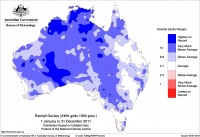La Ni�a dominates the Bureau?s Annual Climate Statement 2011
21/02/2012

The Bureau of Meteorology has released its Annual Climate Summary for 2011 today, providing a comprehensive record of Australia’s weather and climate for the previous year.
The Statement confirms last year was Australia's second wettest year on record, with widespread and severe flooding across northern and eastern Australia.
Last year's weather was dominated by two La Niña events. The first, one of the strongest in recorded history, began in 2010 and continued into the autumn of 2011. The second, weaker event formed toward the end of September 2011.
These back-to-back La Niña events contributed to a two-year rainfall record of 1408mm (2010-11), just surpassing the previous record of 1407mm set in 1973-74.
Although annual temperatures in Australia were below average, globally it was the warmest La Niña year on record. In contrast to the national pattern, the southwest of Australia (including Perth) recorded its hottest year on record.
Ocean temperatures around Australia continued to be well above average, with record temperatures recorded in parts of the eastern Indian Ocean.
In February tropical cyclone Yasi, which developed near the Fijian islands, became the strongest tropical cyclone to make landfall since 1918, also a La Niña year. Two weeks later, Carlos brought heavy rainfall and flash flooding to northern Australia between 15 and 17 February. The year ended with tropical cyclone Grant also impacting the Top End, bringing flash flooding in late December.
Globally, 2011 saw the 11th highest mean temperature on record according to data released by the World Meteorological Organization, with 13 of the warmest years on record having occurred in the past 15 years.
For further information go to our Annual climate reports.










